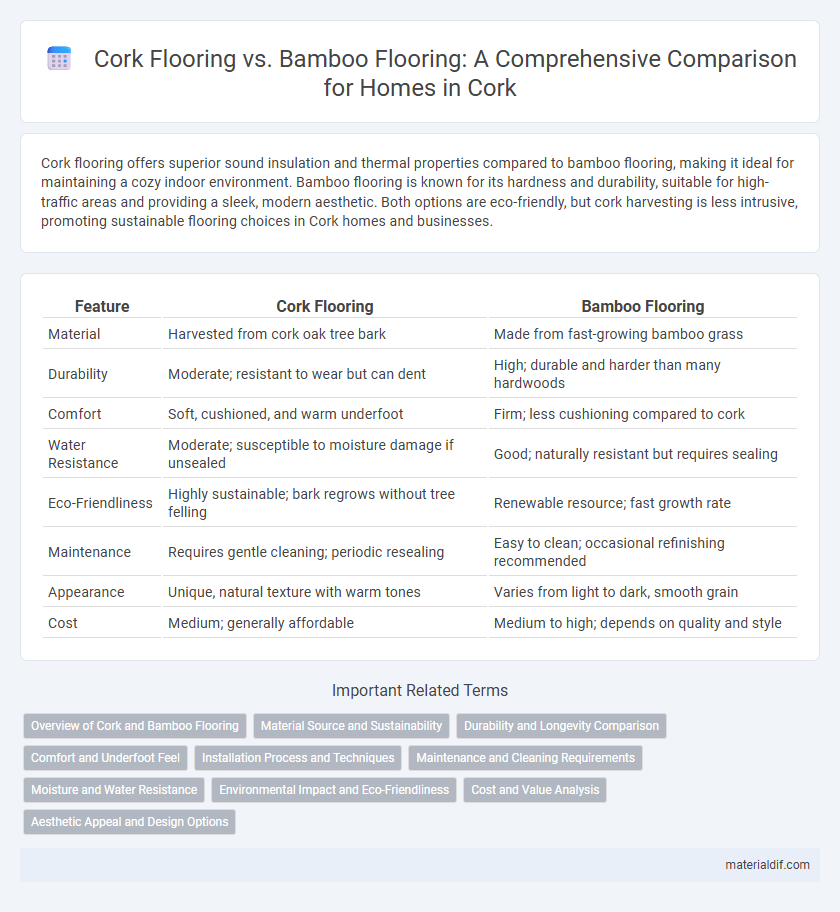Cork flooring offers superior sound insulation and thermal properties compared to bamboo flooring, making it ideal for maintaining a cozy indoor environment. Bamboo flooring is known for its hardness and durability, suitable for high-traffic areas and providing a sleek, modern aesthetic. Both options are eco-friendly, but cork harvesting is less intrusive, promoting sustainable flooring choices in Cork homes and businesses.
Table of Comparison
| Feature | Cork Flooring | Bamboo Flooring |
|---|---|---|
| Material | Harvested from cork oak tree bark | Made from fast-growing bamboo grass |
| Durability | Moderate; resistant to wear but can dent | High; durable and harder than many hardwoods |
| Comfort | Soft, cushioned, and warm underfoot | Firm; less cushioning compared to cork |
| Water Resistance | Moderate; susceptible to moisture damage if unsealed | Good; naturally resistant but requires sealing |
| Eco-Friendliness | Highly sustainable; bark regrows without tree felling | Renewable resource; fast growth rate |
| Maintenance | Requires gentle cleaning; periodic resealing | Easy to clean; occasional refinishing recommended |
| Appearance | Unique, natural texture with warm tones | Varies from light to dark, smooth grain |
| Cost | Medium; generally affordable | Medium to high; depends on quality and style |
Overview of Cork and Bamboo Flooring
Cork flooring offers natural shock absorption, thermal insulation, and hypoallergenic properties, making it a popular choice for eco-friendly interior design. Bamboo flooring provides high durability and a distinctive grain pattern, harvested from fast-growing grasses, which makes it a sustainable alternative to traditional hardwood. Both materials are renewable, but cork is harvested from the bark of cork oak trees without harming the tree, while bamboo regenerates rapidly from its root system.
Material Source and Sustainability
Cork flooring is sourced from the bark of the cork oak tree, harvested sustainably every 9 to 12 years without harming the tree, making it an eco-friendly material with a renewable lifecycle. Bamboo flooring is derived from fast-growing bamboo grass, which can be harvested every 3 to 5 years, offering a highly renewable resource but sometimes involves intensive processing and transportation impacts. Both materials provide sustainable alternatives to traditional hardwood floors, with cork excelling in biodegradability and bamboo in rapid renewability.
Durability and Longevity Comparison
Cork flooring offers excellent durability with its natural resilience and ability to compress under pressure, making it ideal for areas with moderate foot traffic. Bamboo flooring, known for its hardness and resistance to dents, generally provides greater longevity, especially in high-traffic environments, due to its dense fiber structure. Both materials require proper maintenance, but bamboo's superior toughness often results in a longer lifespan compared to cork.
Comfort and Underfoot Feel
Cork flooring offers exceptional cushioning and warmth due to its cellular structure, providing a soft, resilient underfoot feel that reduces fatigue during prolonged standing. Bamboo flooring, while harder and less forgiving, presents a firmer surface with a smooth texture that is more durable but less comfortable for extended periods. The natural elasticity of cork makes it ideal for comfort-focused spaces, whereas bamboo suits high-traffic areas where sturdiness is prioritized.
Installation Process and Techniques
Cork flooring installation typically involves click-lock planks that float over underlayment, allowing for a straightforward, DIY-friendly process requiring minimal adhesive. Bamboo flooring often demands a more complex installation, with options ranging from click-lock systems to nail-down or glue-down methods, necessitating precise subfloor preparation. Both materials benefit from acclimatization to indoor conditions before installation to minimize expansion or contraction after laying.
Maintenance and Cleaning Requirements
Cork flooring requires regular sweeping and occasional damp mopping to prevent dirt buildup and maintain its natural resilience, while bamboo flooring demands frequent dusting and gentle cleaning with a pH-neutral cleaner to avoid surface damage. Cork is more resistant to mold and mildew due to its natural antimicrobial properties, reducing the frequency of deep cleaning compared to bamboo. Bamboo floors are more sensitive to moisture and need careful wiping of spills to prevent warping or staining, making maintenance slightly more intensive than cork.
Moisture and Water Resistance
Cork flooring offers excellent moisture resistance due to its natural cellular structure that repels water and prevents mold growth, making it ideal for kitchens and basements. Bamboo flooring, while harder and durable, is more susceptible to water damage if not properly sealed, as excessive moisture can cause swelling and warping. For areas prone to humidity and water exposure, cork flooring provides superior protection and longevity compared to traditional bamboo flooring.
Environmental Impact and Eco-Friendliness
Cork flooring is highly sustainable, harvested from the bark of cork oak trees without harming them, allowing the bark to regenerate every 9-12 years, making it an eco-friendly choice with low carbon emissions. Bamboo flooring, while fast-growing and generally renewable, often requires heavy chemical treatment and long-distance transportation, increasing its environmental footprint compared to locally sourced cork. Both options provide biodegradable alternatives to traditional flooring, but cork offers superior carbon sequestration and minimal processing impacts, enhancing its green credentials.
Cost and Value Analysis
Cork flooring typically costs between $3 to $8 per square foot, offering excellent insulation and durability, making it a cost-effective choice for energy savings. Bamboo flooring ranges from $5 to $10 per square foot and provides superior hardness and longevity, which justifies its higher upfront price for long-term value. When comparing cost and value, cork flooring excels in comfort and eco-friendliness, while bamboo flooring offers better resale value and resistance to wear in high-traffic areas.
Aesthetic Appeal and Design Options
Cork flooring offers a warm, natural texture with a unique, speckled pattern that complements rustic and modern interiors in Cork homes. Bamboo flooring provides a sleek, smooth finish with diverse color variations ranging from light natural tones to darker, carbonized shades, ideal for contemporary Cork design trends. Both materials deliver versatile design options, but cork's softer, matte appearance contrasts with bamboo's polished, linear grain for aesthetic appeal.
Cork Flooring vs Bamboo Flooring Infographic

 materialdif.com
materialdif.com